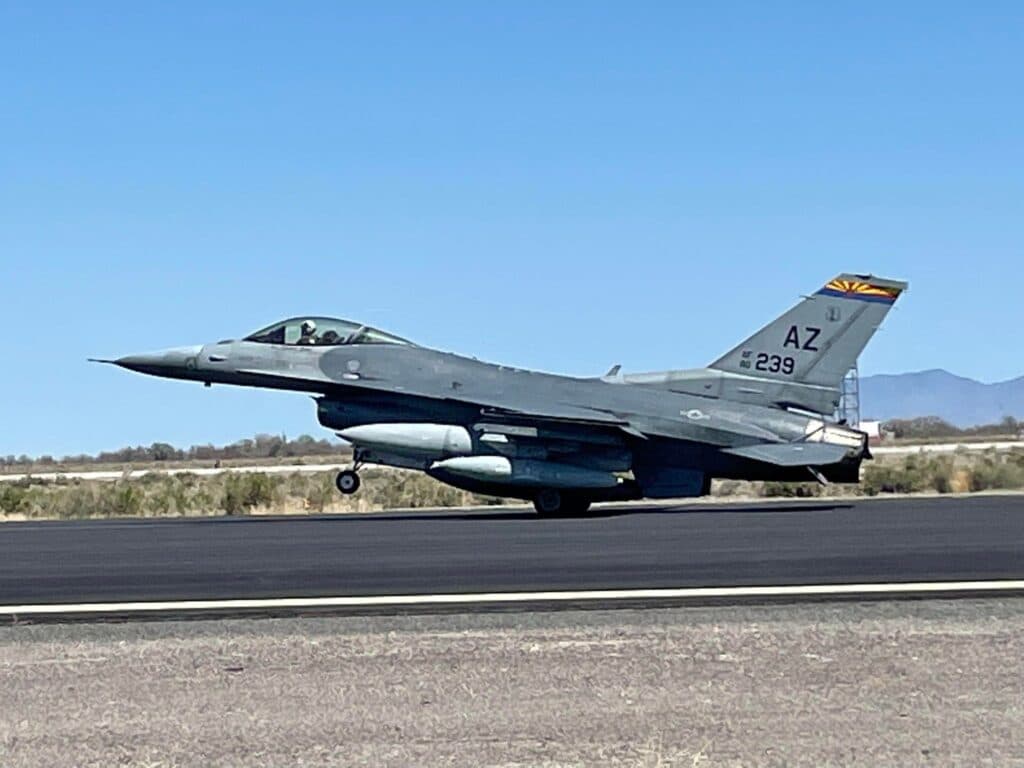US Navy recently received the first of its F-16 Vipers retired by the US Air Force (USAF) as part of the plan to increase its adversary air capabilities.
The F-16C/Ds are replacing the F-5N Tiger 2s belonging to Fleet Composite Squadron (VFC) 13 “Fighting Saints,” at Naval Air Station Fallon in Nevada which is the Navy’s Reserve Force Squadron that specializes in replicating adversary threats or ‘red air’ in support of the Naval Aviation Warfighting Development Center (NAWDC).
While the VFC-13’s F-5s are being sent to Naval Air Station Joint Reserve Base New Orleans, Louisiana to replace the aging F/A-18 Legacy Hornets belonging to Strike Fighter Squadron VFA-204 or ‘River Rattlers’, another Naval Reserve unit specializing in red air.
Recently, the first image of an F-5N assigned to the “River Rattlers” emerged revealing the unit’s new VFC-204 identity as the unit prepares to end Hornet operations this summer and be officially re-designated from a strike fighter (VFA) to a fleet composite (VFC) squadron in October.
The US Navy is set to receive a total of 20 single-seat Block 32 F-16Cs and 6 two-seat Block 25 F-16Ds, as the USAF retires them as part of a divestment scheme to retire 124 F-16s by 2026 so that the service can consolidate on post-Block examples that are Block 40 and above.

Out of these VFC-13 at Fallon will receive 12 Block 32 F-16Cs and lose all of its F-5s this year to re-equip the River Rattlers in New Orleans, Louisiana. While the Fallon’s NAWDC will receive 8 Block 32 F-16Cs and 6 Block 25 F-16Ds to replace its remaining Legacy Hornets.
Block 25 and Block 32 F-16C/D
Block 25 F-16C entered the USAF service in 1984. The aircraft version featured the Westinghouse AN/APG-68 radar and is known to have improved precision night-attack capability over the previous variants.
Also, Block 25 introduced a huge improvement in cockpit avionics, including improved fire-control and stores management computers, an Up-Front Controls (UFC) integrated data control panel, data-transfer equipment, multi-function displays, and radar altimeter, etc.
While, the Block 32 F-16Ds are also reported to have been upgraded which includes the addition of improved inertial guidance systems, an improved electronic warfare suite (AN/ALQ-213), and the addition of a Northrop Grumman LITENING targeting pod.
The Embedded GPS/INS (EGI) system which combines a Global Positioning System (GPS) receiver with an Inertial navigation system (INS), provides the capability to use Joint Direct Attack Munition (JDAM) and other GPS-aided munitions.
The LITENING pod consists of high-definition video, laser imaging sensors, forward-looking infrared (FLIR) sensors and multiple plug-and-play data link options, advanced image processing, and digital video output. These features provide superior imagery to allow the identification of targets in different battlefield conditions.
Now, these F-16s will be further upgraded for transforming Fallon’s adversary capabilities to provide modern threat replication in support of some of the highest-end air combat training the US Navy does, including supporting Topgun, and Fleet Replacement Squadrons, Carrier Strike Groups, Carrier Air Wings and Unit Deployment Plan training.
The F-16s will undergo airframe strengthening to prevent aircraft grounding due to fatigue and extend their service life to 8,000 equivalent flight hours.
Advanced AESA Radar
Also, the F-16s of Fallon’s NAWDC will be upgraded with the new Northrop Grumman AN/APG-83 Active Electronically Scanned Array (AESA) radar to make them the most capable adversary F-16s currently in the U.S. inventory so that they are better able to challenge the Navy’s modern fourth- and fifth-generation fleet strike fighters.
The addition of the APG-83 provides the F-16s with advanced capabilities similar to fifth-generation fighters like the F-22 and F-35. Compared to the existing mechanically scanned radar such as APG-68, the APG-83 can detect, track and identify greater numbers of targets much faster and at much longer ranges.
The new AESA radar will enhance the F-16’s ability to counter increasingly sophisticated threats such as low flying enemy cruise missiles that will have small radar cross-sections. The APG-83 is also said to have resistance to being jammed or being fooled by enemy countermeasures.
The US Navy’s approach to increasing its aggressor capabilities is quite similar to what USAF is doing at Nellis Air Force Base, Nevada where it is increasing its in-house F-16 red air fleet and also introducing early F-35As as dedicated aggressors.
The latest Russian aggression in Ukraine and the looming Chinese threat have got the US military worried about conventional military threats from near-peer adversaries.
Therefore, the US Navy and USAF need advanced adversary platforms to challenge their highly capable front-line squadrons and their finest aviators so that they are prepared to face whatever comes at them if they have to go to war.
- Written by Tanmay Kadam/EurAsian Times Desk
- Contact the author at etdesk@eurasiantimes.com
- Follow EurAsian Times on Google News